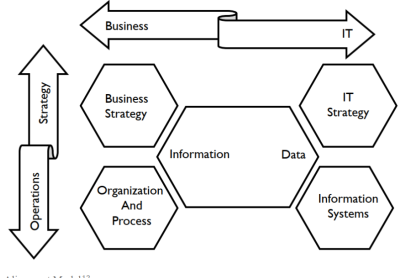
Alignment between Business Strategies, Data, and Technology… The Secret to Success in the Digital Age!

Dr. Hisham Anani
Senior Consultant at Kaizen Consulting
In today’s world, data and technology have become essential elements for making effective decisions and achieving organizational excellence. However, the important question is:
How do we achieve alignment between business strategy, data strategy, and information technology strategy?
The answer lies in two leading models used to achieve this alignment:
- Strategic Alignment Model (SIM)
- Amsterdam Information Model (AIM)
Strategic Alignment Model (SIM)
The Strategic Alignment Model (SIM) was developed by Henderson and Venkatraman to achieve consistency between business strategies and information technology strategies in an integrated manner, ensuring that data and technology are used in a way that supports the organization’s long-term goals .
Components of the SIM
The Strategic Alignment Model is based on four main components:
- Business Strategy (Business Strategy):
- Defines the organization’s major goals and business directions.
- Includes elements such as: growth, expansion, and achieving competitive advantage .
- IT Strategy (IT Strategy):
- Relates to how technology is used to support and achieve business strategy goals.
- Includes developing technological systems, infrastructure, and applications that contribute to improving efficiency and reducing costs .
- Organizational Infrastructure (Organizational Infrastructure):
- Relates to the organizational structure and internal processes that support business strategy and IT strategy.
- Includes organizational culture, team structure, and policies governing work .
- IT Infrastructure (IT Infrastructure):
- Relates to the core IT systems that ensure the continuity of operations, including servers, networks, and databases that support the daily use of technology in the organization .
How the SIM model works
The SIM model demonstrates that there is interaction between these four components. The alignment between these components is necessary for success. For example, : the IT strategy must be designed to support the business strategy and not just be standalone systems. Similarly, the organizational structure must be able to support coordination between IT and business teams .
- Business strategy requires an IT strategy that supports its objectives.
- Organizational infrastructure must align with IT infrastructure to ensure facilitation of collaboration and strategy implementation.

Amsterdam Information Model (AIM)
Definition
The Amsterdam Information Model (AIM) was developed by:
Abcouwer, Maes, and Truijens It is a framework developed to link business strategy with information technology in the organization. This model points to the relationships that affect how information is managed in organizations, taking into account organizational structure, corporate culture, and tactics, which enhances the ability to use data strategically .
Components of the AIM model
The AIM model consists of a matrix with 9 interconnected cells or elements, divided into three main layers: nested from outside to inside – strategy, tactics, and operations. This model primarily focuses on data governance and quality in the business context.
First Level – Strategy:
- Business strategy and governance: Defining the organization’s strategic objectives.
- Information strategy and governance: Guiding information strategies to support decision-making.
- IT strategy and governance: How to use technology to achieve business strategy objectives.
Second Level – Tactics:
- Organizational structure and processes: Organizing the institution to ensure integration between departments to achieve strategies.
- Information architecture and planning: Storing and organizing information to ensure efficient access.
- IT infrastructure and planning: Planning the use of IT infrastructure to support organizational strategies.
Third Level – Operations:
- Business execution: Transforming strategies into actionable procedures and processes.
- Information management and use: Ensuring effective data management and supporting decision-making.
- IT services: Providing IT services to support business and achieve quality.
Relationships between Components
The model includes multiple elements that affect data management and information technology:
- Horizontal perspective: Links business strategy with IT strategy.
- Vertical perspective: Links business strategy with daily operational business processes.
- Data governance and quality: This pillar is fundamental to AIM, ensuring that data is managed efficiently at all levels of the organization.
How the AIM model works
The AIM model enhances communication between technical and business teams. It ensures that the data strategy aligns with operational needs, making IT a vital element in the business strategy. It also promotes data governance and encourages quality improvement to ensure effective data use across the organization .
Therefore, in light of rapid changes, organizations that align technology with their business and data strategies will be able to: lead the market, make smarter decisions, and leverage digital transformation to its fullest potential.
Is your organization applying one of these models?
